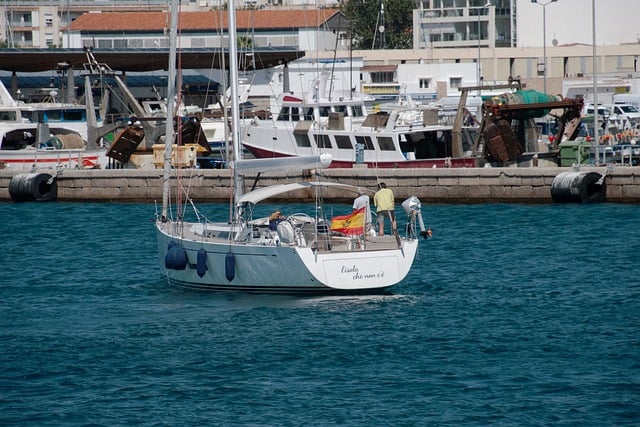When selecting a marine battery, it's crucial to differentiate between starter and deep-cycle types to match the unique demands of maritime applications. Starter batteries are for high-energy discharges needed to start engines, while deep-cycle batteries handle sustained power use, with flooded lead-acid batteries being cost-effective but requiring maintenance, and AGM or gel cell batteries offering maintenance-free and spill-proof designs suitable for various marine environments. The right choice depends on your vessel's electrical demands, budget, space constraints, and intended use. For optimal performance, safety, and reliability on the water, a carefully selected marine battery is essential. Proper installation involves correct terminal orientation, ensuring ventilation to dissipate hydrogen gas safely, and securing the battery to prevent movement and vibration damage. Regular maintenance checks are necessary to address issues like corrosion or electrolyte levels in lead-acid batteries, ensuring your marine battery operates at its best for as long as possible.
Embarking on a maritime adventure or maintaining your vessel involves a critical component: the marine battery. A well-functioning battery not only powers your navigation system but also ensures the safety and performance of your watercraft. This article outlines seven pivotal mistakes to sidestep during battery installation, emphasizing the necessity for accurate sizing, proper charging protocols, and secure placement to enhance both longevity and reliability. From understanding the diverse roles of marine batteries to performing regular maintenance checks, these insights will guide you in extending your battery’s lifespan and safeguarding your trips on the open sea. Navigate through each section to master the art of marine battery care and avoid common pitfalls that could disrupt your sailing experience.
- Understanding Marine Battery Types and Their Roles
- The Importance of Proper Sizing for Your Marine Battery Needs
- Avoiding Overcharging: Setting Up a Correct Charging Regimen
- The Consequences of Incorrect Battery Installation Orientation
- Ensuring Adequate Ventilation to Prevent Gassing and Overheating
- Securing the Battery Properly to Prevent Movement and Vibration Damage
- Regular Maintenance Checks to Extend Your Marine Battery's Lifespan
Understanding Marine Battery Types and Their Roles

When installing a marine battery, it’s crucial to have a comprehensive understanding of the different types available and their specific roles within a maritime context. Marine batteries are distinct from automotive batteries due to the harsh conditions they face on board a vessel, including frequent vibrations, temperature fluctuations, and exposure to corrosive salts. There are primarily two main types of marine batteries: starter (or cranking) batteries and deep-cycle batteries. Starter batteries are designed to deliver a large burst of energy for starting the boat’s engine. They typically have a higher capacity for short-duration discharge compared to deep-cycle batteries, which are built for sustained power usage. Deep-cycle batteries are specifically engineered to handle multiple discharges and recharges without compromising their performance or lifespan. Understanding these differences is key to selecting the right battery for your maritime needs, as each type has its optimal application—be it starting the engine or powering onboard electronics, trolling motors, or other 12-volt systems on your vessel.
Furthermore, within deep-cycle batteries, there are two main categories: flooded lead-acid (FLA) and absorbed glass mat (AGM) or gel cell batteries. FLA batteries are often more cost-effective but require maintenance, such as topping up the water in the battery electrolyte solution. AGM and gel cell batteries, on the other hand, offer spill-proof construction and maintenance-free operation, making them ideal for a variety of marine applications where space and convenience are paramount. Each type of marine battery has its advantages and considerations, from weight to lifespan to recovery time. Proper understanding and selection of the right marine battery will not only ensure optimal performance but also enhance the safety and reliability of your maritime activities.
The Importance of Proper Sizing for Your Marine Battery Needs

When selecting a marine battery, proper sizing is paramount to ensure optimal performance and longevity for your nautical adventures. A battery that’s too small may struggle to start your engine or power your electronics consistently, leading to frustration and potential safety issues. Conversely, an oversized battery might be unnecessarily expensive and could risk damage due to being chronically overcharged. Understanding your marine battery needs starts with assessing the power requirements of your vessel’s electrical systems, including the starting motor, navigation lights, fish finders, and any other onboard electronics. Take into account the size of your boat, the expected duration of your trips, and how you plan to use the boat to determine the right amp-hour rating for your marine battery. For instance, if you’re using trolling motors frequently, a higher capacity battery will be required. Additionally, consider the types of batteries available: lead-acid, AGM, or lithium, each with its own characteristics and ideal use cases within the marine environment. Proper sizing not only contributes to the reliability of your vessel but also ensures that you have a safe and enjoyable experience on the water. It’s an aspect of boat maintenance that should not be overlooked for the sake of convenience or cost savings in the short term.
Avoiding Overcharging: Setting Up a Correct Charging Regimen

When installing a marine battery, one of the most critical aspects to consider is establishing a correct charging regimen to prevent overcharging. Overcharging can lead to reduced battery life and even cause the battery to fail prematurely. To avoid this pitfall, it’s essential to understand the specific charge requirements of your marine battery. These batteries are designed to handle the demands of maritime environments but require a charging system that matches their capacity and type. A proper charging regimen involves selecting a charger compatible with the marine battery’s chemistry, whether it be lead-acid, AGM, or lithium-ion. Chargers come with various modes and settings, including float, maintenance, and bulk charging modes, each tailored to different stages of the battery’s charge cycle. Additionally, setting up a smart charger with automatic voltage selection can greatly reduce the risk of overcharging, as it adjusts the charging parameters to suit the battery’s needs. Regular monitoring of the battery’s state of charge and voltage levels is also recommended to ensure it remains within safe operating limits. By implementing these measures, you can safeguard your marine battery against the detrimental effects of overcharging, thereby ensuring its longevity and optimal performance on the water.
The Consequences of Incorrect Battery Installation Orientation

When installing a marine battery, ensuring the correct orientation is paramount due to the potential hazards associated with incorrect placement. A marine battery, unlike its automotive counterpart, has a specific positive and negative terminal configuration that must be adhered to. Incorrect installation can lead to improper charging and discharging, which may cause the battery to overheat, reducing its lifespan and potentially leading to catastrophic failure. Over time, consistent misuse can result in internal gas buildup, swelling, or even an explosion. The orientation of the battery is also critical for optimal performance; installing it upside down or at an angle can hinder the flow of electrons and reduce efficiency. In addition to these safety concerns, incorrect orientation may also lead to loose connections, which can cause arcing and potentially start a fire on board. It’s imperative to refer to the manufacturer’s guidelines for proper battery installation, ensuring that all terminals are securely connected and that the battery is positioned correctly in its compartment to avoid these risks and ensure long-term reliability and safety on the water.
Ensuring Adequate Ventilation to Prevent Gassing and Overheating

When installing a marine battery, one of the critical aspects to consider for safety and longevity is ensuring adequate ventilation around the battery. Proper ventilation is essential to prevent the accumulation of hydrogen gas, which is a natural byproduct of the battery’s electrochemical reactions. This gas, although odorless and colorless, can be highly explosive when concentrated in enclosed spaces. To mitigate this risk, it’s crucial to install the marine battery in a well-ventilated compartment where fresh air can circulate freely. This not only helps in dispersing any hydrogen gas but also aids in dissipating excess heat generated by the battery during operation. Overheating can significantly reduce the lifespan of the battery and potentially lead to dangerous situations such as thermal runaway or even explosion. Therefore, when selecting the installation location, consider the proximity to heat sources and ensure that there is ample space for natural convection currents to cool the battery effectively. Additionally, installing a marine battery in a compartment with proper ventilation will also enhance its performance by maintaining optimal temperatures, ensuring the battery can deliver its best output consistently. Remember to secure the battery properly to prevent movement that could damage internal components or cause short circuits, while still allowing for temperature-induced expansion and contraction. By adhering to these guidelines, you can significantly reduce the risks associated with battery installation and ensure a safer boating experience.
Securing the Battery Properly to Prevent Movement and Vibration Damage

When installing a marine battery, ensuring it is securely fastened is paramount to prevent both movement and potential vibration damage. A snug fit not only contributes to the safety of your vessel but also optimizes the performance of the battery. The jostling caused by waves and regular operation can otherwise lead to internal component displacement or even cracks within the battery, significantly shortening its lifespan. Optimal placement is crucial; the battery should be installed on a stable platform that can withstand the marine environment’s rigors. It’s important to follow the manufacturer’s guidelines for mounting, which often involve specific brackets or holders designed to absorb and dissipate vibrations. Additionally, the mounting points should be checked regularly to ensure they remain secure over time, as corrosion from saltwater can loosen fastenings. For peak performance and longevity of your marine battery, proper installation and securing are essential steps that should not be overlooked.
Regular Maintenance Checks to Extend Your Marine Battery's Lifespan

Regular maintenance checks are pivotal for extending the lifespan of your marine battery. To maintain optimal performance and longevity, it’s crucial to inspect the battery and its connections frequently. This includes examining the terminals for corrosion, ensuring secure fastenings, and verifying the cleanliness of all connections. Corrosion on terminals can lead to poor electrical conductivity, causing inefficiencies and potentially damaging the battery over time. Loose or improperly connected terminals can also result in a poor connection, which can strain the battery and reduce its service life. Additionally, monitoring the water levels in flooded-type lead-acid batteries is essential, as low electrolyte levels can impair battery function and shorten its lifespan. Regularly topping off the electrolyte solution with distilled water, as per the manufacturer’s instructions, helps maintain consistent performance. By implementing a routine of thorough inspections and timely maintenance, marine battery users can significantly enhance their battery’s performance and extend its operational life. This proactive approach to care can save time and money in the long run by avoiding costly repairs or premature replacements.
When embarking on a maritime adventure, having a well-functioning marine battery system is paramount. This article has highlighted seven pivotal mistakes to avoid during installation, ensuring your marine battery operates at its best. From grasping the distinct roles of different marine batteries to securing them properly to prevent vibration damage, each step in the installation process must be approached with care and precision. Proper sizing, a balanced charging regimen, and regular maintenance checks are not just recommendations but essential practices for extending your marine battery’s lifespan. By adhering to these guidelines, you can enhance both safety and reliability on the water. Remember to handle your marine batteries with diligence and attention to detail to avoid common pitfalls and enjoy a seamless experience on the open sea.
